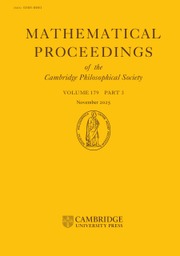Crossref Citations
This article has been cited by the following publications. This list is generated based on data provided by
Crossref.
Carrasco, P.
and
Cegarra, A.M.
1996.
(Braided) tensor structures on homotopy groupoids and nerves of (Braided) categorical groups1.
Communications in Algebra,
Vol. 24,
Issue. 13,
p.
3995.
Carrasco, Pilar
Garzón, Antonio R.
and
Miranda, Jesús G.
2000.
Schreier theory for singular extensions of categorical groups and homotopy classification∗∗.
Communications in Algebra,
Vol. 28,
Issue. 5,
p.
2585.
Cegarra, Antonio M.
and
Garzón, Antonio R.
2001.
Homotopy Classification of Categorical Torsors.
Applied Categorical Structures,
Vol. 9,
Issue. 5,
p.
465.
Vitale, Enrico M.
2002.
A Picard–Brauer exact sequence of categorical groups.
Journal of Pure and Applied Algebra,
Vol. 175,
Issue. 1-3,
p.
383.
Vitale, Enrico M.
2003.
On the categorical structure of H2.
Journal of Pure and Applied Algebra,
Vol. 177,
Issue. 3,
p.
303.
Garzón, A.R.
Inassaridze, H.
and
Río, A. del
2004.
Derivations of categorical groups.
Theory and Applications of Categories,
Vol. 13,
Issue. ,
p.
86.
Carrasco, Pilar
and
Martínez-Moreno, Juan
2004.
Simplicial Cohomology with Coefficients in Symmetric Categorical Groups.
Applied Categorical Structures,
Vol. 12,
Issue. 3,
p.
257.
Muro, Fernando
and
Tonks, Andrew
2007.
The 1-type of a Waldhausen K-theory spectrum.
Advances in Mathematics,
Vol. 216,
Issue. 1,
p.
178.
Cegarra, A.M.
and
Khmaladze, E.
2007.
Homotopy classification of graded Picard categories.
Advances in Mathematics,
Vol. 213,
Issue. 2,
p.
644.
Baues, Hans-Joachim
and
Muro, Fernando
2008.
Secondary homotopy groups.
Forum Mathematicum,
Vol. 20,
Issue. 4,
Muro, F.
2010.
Maltsiniotis's First Conjecture for K1.
International Mathematics Research Notices,
Noohi, Behrang
2011.
Group cohomology with coefficients in a crossed module.
Journal of the Institute of Mathematics of Jussieu,
Vol. 10,
Issue. 2,
p.
359.
Jibladze, Mamuka
and
Pirashvili, Teimuraz
2012.
Cohomology with coefficients in stacks of abelian 2-groups.
Journal of Pure and Applied Algebra,
Vol. 216,
Issue. 10,
p.
2274.
Johnson, Niles
and
Osorno, Angélica M.
2012.
Modeling Stable One-Types.
Theory and Applications of Categories,
Vol. 26,
Issue. ,
p.
520.
Carrasco, P.
and
Cegarra, A.M.
2017.
A Dold-Kan theorem for simplicial Lie algebras.
Theory and Applications of Categories,
Vol. 32,
Issue. ,
p.
1165.
 for simplicial sets, or topological spaces, with coefficients in symmetric cat-groups
for simplicial sets, or topological spaces, with coefficients in symmetric cat-groups  . This cohomology is the usual one when abelian groups are taken as coefficients, and the main topological significance of this cohomology is the fact that it is equivalent to the reduced cohomology theory defined by a Ω-spectrum, {
. This cohomology is the usual one when abelian groups are taken as coefficients, and the main topological significance of this cohomology is the fact that it is equivalent to the reduced cohomology theory defined by a Ω-spectrum, { }, canonically associated to
}, canonically associated to  . We use the spaces
. We use the spaces  to prove that symmetric cat-groups model all homotopy type of spaces X with Πi(X) = 0 for all i ╪ n, n + 1 and n ≥ 3, and then we extend Eilenberg–MacLane's classification theorem to those spaces:
to prove that symmetric cat-groups model all homotopy type of spaces X with Πi(X) = 0 for all i ╪ n, n + 1 and n ≥ 3, and then we extend Eilenberg–MacLane's classification theorem to those spaces:  .
.
